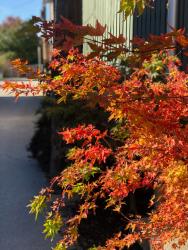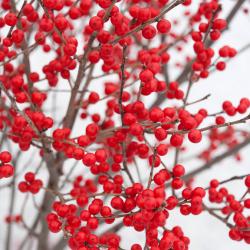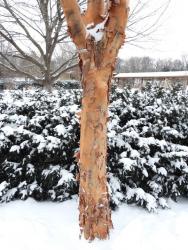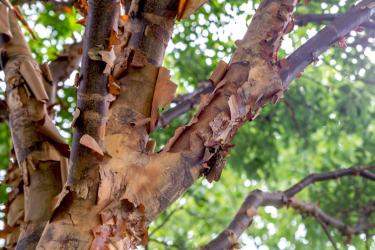Low-maintenance beauty: Sango Kaku won’t require much work! Mulch will help retain moisture and keep the roots cool. The plant needs little pruning, but if you do opt to prune your plant, avoid doing so in spring when the sap is running.
Japanese maples are always a colorful addition to any garden: lovely, feathery spring foliage in soft, bright colors, sculptural shapes year-round and fiery autumnal displays. But Acer palmatum “Sango Kaku” goes the extra mile—when cool temperatures arrive, their bark begins to deepen into a glowing, flamingo pink that stays vibrant all winter. A truly brilliant display from this upright, vase-shaped tree whose name translates to “coral tower.” Hardy and adaptable to most soil and climate conditions and happy in full sun to part shade, Sango Kaku asks only for love and consistent watering. Kathie Hoyer, Bowood Farms.
Year-round beauty: The paperbark maple isn’t just an asset to your winter garden! Its colorful show begins in early spring with three lobes that are green and silver, making it a small shade tree for the summer months. In late fall, expect the foliage to turn colors from bright yellow, vibrant orange and crimson red.
A handsome tree with an oval to rounded crown, an open habit, and upright branching, Paperbark maples will bring color to your garden. Soft green leaves turn scarlet in the fall. It becomes distinctive and elegant with age as its papery sheets of bark peel to reveal cinnamon-brown new bark. Paperbark maples are an excellent small landscape specimen or woodland understory accent. Ideally, plant these trees in filtered sun. Water regularly; this tree can tolerate wetlands. They are best planted in early fall or mid-spring. David Sherwood, Sherwood’s Forest Nursery.
Beautiful fall color, great branching structure and beautiful cinnamon-red exfoliating bark make acer griseum (Paperbark Maple) a good choice for winter color. They are low-maintenance; for upkeep, prune the crossing branches and deadwood to maintain good air flow and structure. Justin Verbryck, Frisella Nursery.
It's hard to top Winterberry Holly, Ilex verticillata, for a colorful display in the middle of winter. A type of native Missouri Holly, Winterberry loses its leaves each fall. What's left is an eye-popping view of thousands of brightly colored berries clinging to every stem. It makes a fantastic hedge or showy focal point. Hybrids of Winterberry have been developed that have an abundance of plump berries. Heights can range from 3 feet to 15 feet in the wild. Its width depends on where it is grown. In wet sites, it will spread to form a dense thicket. In drier soil, it matures to a tighter clump. Regardless, it is easy to grow in any soil in full sun to part shade. Ann Lapides, Sugar Creek Gardens.











